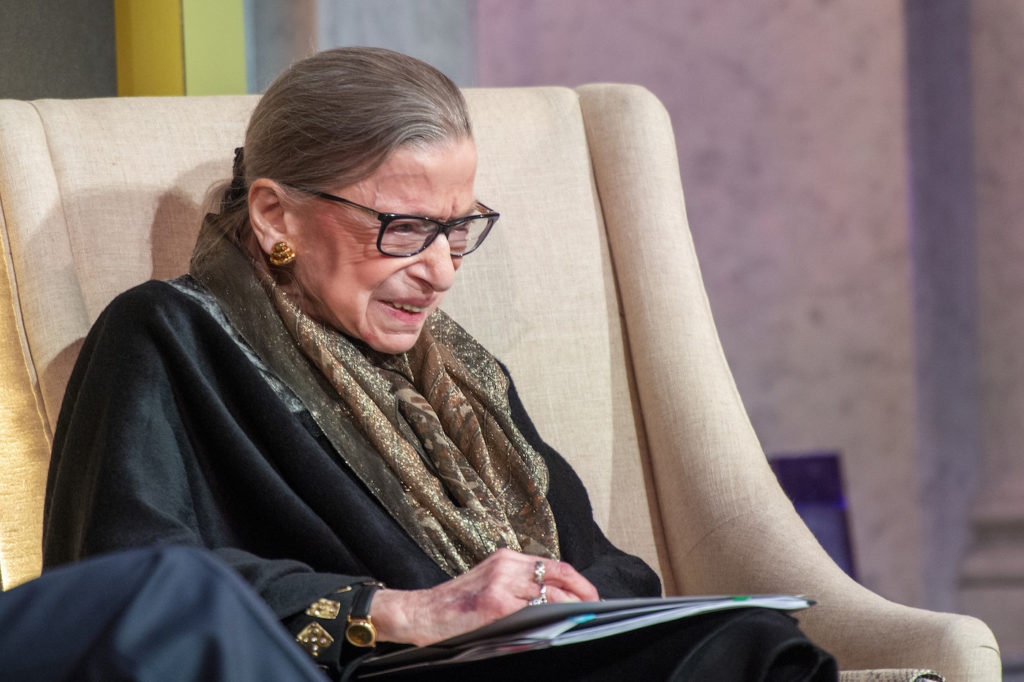The upcoming Supreme Court decision in Dobbs v. Jackson Women’s Health Organization will inevitably be momentous. In Dobbs, the Supreme Court granted certiorari to decide “whether all pre-viability prohibitions on elective abortions are unconstitutional.” And both sides agree that the only way to answer that question is either to fully reverse or fully reaffirm Roe v. Wade.
The originalist critique of Roe is straightforward, succinctly stated by Justice White in his dissent in Roe’s companion case, Doe v. Bolton: “I find nothing in the language or history of the Constitution to support the Court’s judgment. The Court simply fashions and announces a new constitutional right for pregnant mothers and, with scarcely any reason or authority for its action, invests that right with sufficient substance to override most existing state abortion statutes.”
But the curious thing is that everyone—from pro-choice academics to the Roe majority itself—largely agreed with Justice White’s criticism at the time.
Progressives on Roe’s Lack of Constitutional Basis
Start your day with Public Discourse
Sign up and get our daily essays sent straight to your inbox.The Roe majority was quite aware that it was, to put it charitably, breaking new ground in Roe. Writing for the Court, Justice Blackmun opined that the right to abortion was a natural extension of the right to privacy that the Court found lurking in the “penumbras, formed by emanations” from the First, Third, Fourth, Fifth, and Ninth Amendments in Griswold v. Connecticut. In Roe, the Court acknowledged that the right to privacy appears nowhere in the Constitution, but nonetheless found (tepidly) that such a right exists in the Fourteenth Amendment (which is not on the list in Griswold). The Court announced without much explanation that wherever the “right to privacy” may be found, it “is broad enough to encompass a woman’s decision whether or not to terminate her pregnancy.” And that right to terminate a pregnancy, the Court announced in similarly cursory fashion, is “fundamental” and “implicit in the concept of ordered liberty.”
A state’s interest in protecting life—a guarantee that does appear in the text of the Constitution—was merely “important and legitimate.” But that interest does not become “compelling,” such that the state can act on it, until the point of viability. The Court’s single-sentence justification? “This is so because the fetus then presumably has the capability of meaningful life outside the mother’s womb.”
The judiciary, Alexander Hamilton opined in Federalist 78, has the power of “neither force nor will, but merely judgment.” And for that reason, the judiciary is the only branch of government that has to show its work: to set down in writing the reasons underlying its decisions. And even pro-abortion scholars who approved the outcome or direction of Roe could not defend the decision on the terms its authors offered. The Court would be roundly criticized for the basic lack of justification undergirding Roe—and lack of an attempt at offering one. In the months immediately after Roe, progressive law professor Laurence Tribe described the Court’s tweet-length rationale as “mistak[ing] a definition for a syllogism,” and offering “no reason at all for what the Court has held.” It is telling that despite his approval of “the direction in which Roe may take the Court,” Professor Tribe devoted a 53-page article to coming up with an alternative justification for its holding.
Pro-choice Professor John Hart Ely likewise criticized Roe as “bad constitutional law . . . because it is not constitutional law and gives almost no sense of an obligation to try to be.” The “fundamental right” Roe sought to protect is far from being one that is “objectively[] ‘deeply rooted in this nation’s history and tradition,’ and ‘implicit in the concept of ordered liberty’” as the Court’s substantive due process analysis requires. Rather, as Ely argued “this super-protected right is not inferable from the language of the Constitution, the framers’ thinking respecting the specific issue, any general value derivable from provisions they included, or the nation’s governmental structure.” In short, Roe was bad law because the Court was simply making things up. And if a decision, like Roe, “lacks connection with any value the Constitution marks as special, it is not a constitutional principle and the Court has no business imposing it.”
One of Justice Blackmun’s clerks, Edward Lazarus, was similarly unimpressed with Roe. While Lazarus is firmly committed to the right to abortion, and even believes it can be found somewhere in the Constitution, he nonetheless opined that “[a]s a matter of constitutional interpretation and judicial method, Roe borders on the indefensible.” Why? For the simple fact that the opinion has “little connection to the Constitutional right it purportedly interpreted.” Whereas the Roe majority blithely announced that the right to privacy is (probably) in the Fourteenth Amendment and is broad enough to encompass abortion, Lazarus observed that any right to privacy that broad “has no meaningful foundation in constitutional text, history, or precedent—at least, it does not if those sources are fairly described and reasonably faithfully followed.”
Progressive legal scholar Archibald Cox wisely predicted that Roe would always be controversial, precisely because it lacked a firm foundation. The former solicitor general criticized the Court for failing to “confront the issue in principled terms,” and anticipated that “neither historian, nor layman, nor lawyer will be persuaded that all the prescriptions of Justice Blackmun are part of the Constitution.” A little more than a decade later, then-Judge Ruth Bader Ginsburg echoed Cox’s concerns: “Roe v. Wade sparked public opposition and academic criticism, in part, I believe, because the Court ventured too far in the change it ordered and presented an incomplete justification for its action.”
Regardless of what one thinks of the policy outcome in Roe, there is a sizable and bipartisan consensus that the judgment in Roe is simply indefensible.
Progressives’ Concerns about Roe’s Undermining Legislative Power
Most of Roe’s defenders support its outcome and try to downplay the shaky foundation on which it rests. Professor Tribe’s article and the Supreme Court’s later decision in Planned Parenthood v. Casey are two leading examples of this trend. But therein lay the second major criticism, even from pro-abortion thinkers: the Court’s results-oriented, policy-based decision was one better left in the hands of legislatures.
Rather than leave abortion to the political process—which Ginsburg observed “was moving in the early 1970s” toward a more liberal abortion regime—Roe put an end to that process, in dramatic fashion. After Roe, states could no longer experiment with regulations through the democratic process, but instead had to mold their statutes to fit within the frameworks developed in Roe (as amended by the plurality in Planned Parenthood v. Casey, then amended again in Whole Women’s Health v. Hellerstedt, and again by the Chief Justice’s concurrence in June Medical v. Russo). This limited the states’ ability to react to public opinion and advances in science. Removed from the public square, abortion became a “super-protected right” controlled by five justices (sometimes three, and sometimes just one) in a country of 329 million people.
The systematic flaws of Roe v. Wade, widely acknowledged by a variety of progressive and pro-choice legal scholars, caused the judiciary to become the branch most “dangerous to the political rights of the Constitution.”
The Court’s offense against the democratic process is all the greater because the Court was so obviously adopting a legislative role in both form and substance in Roe. Like a legislature, the Court declined to give much of a public reason for its decision—it announced a rule rather than explain a judgment. And the absence of any attempt at giving reasons for the decision “leaves the opinion to read like a set of hospital rules and regulations,” as Archibald Cox put it. Or as former Obama administration official and Harvard law professor Cass Sunstein observed, “In its first encounter with the abortion question . . . the court took the highly unusual step of setting out a series of rules for legislatures to follow.”
But if something looks like legislation and acts like legislation, then it is probably best left to the legislature. Then-Judge Ginsburg described it this way: “Roe v. Wade . . . invited no dialogue with legislators. Instead, it seemed entirely to remove the ball from the legislators’ court.” By jumping the proverbial gun and “declaring an inviolable fundamental right to abortion, Roe short-circuited the democratic deliberation that is the most reliable method of deciding questions of competing values,” liberal law professor Kermit Roosevelt noted in the Washington Post several years ago.
The result? Provoking a conflict that continues to haunt all three branches of government to this day.
Roe’s Ongoing Fallout
The systematic flaws of Roe v. Wade, widely acknowledged by a variety of progressive and pro-choice legal scholars, caused the judiciary to become the branch most, not “least[,] dangerous to the political rights of the Constitution.” Originally designed to be isolated from political pressure, the judiciary was transformed by Roe into being the proverbial black hole, as legal scholar Adam White recently put it. It is not hard to see how the Court’s intervention poisoned American politics—from the unprecedented filibuster of Miguel Estrada, to the outsized role a single Supreme Court vacancy played in the 2016 presidential election, to President Biden’s Presidential Commission on the Supreme Court and calls to “pack” the Court.
Ginsburg said of Roe that if the Court’s goal was to unify the country around a neutral and durable principle, the Court’s “[h]heavy-handed judicial intervention was difficult to justify and appears to have provoked, not resolved, conflict.” And by usurping the role of gatekeeper of the political and social debate over abortion, the Court “prolonged divisiveness and deferred stable settlement of the issue.” The Court realized as much twenty years later in Planned Parenthood v. Casey, but in a remarkable show of hubris, the Court announced that it was going to “resolve the sort of intensely divisive controversy reflected in Roe” and “call[] the contending sides of a national controversy to end their national division.” Neither Roe nor Casey accomplished that fool’s errand.
Roe is indefensible as a matter of honest constitutional interpretation. It short-circuited the political process and poisoned the Court. Its only justification is that it reached a substantive policy outcome that its proponents happen to like (the surest sign that it should have been left to the democratic process). And it endures only because the Court has thus far been too stubborn or too scared to correct its error. But as Professor Alan Dershowitz put it, in the absence of “clear governing constitutional principles,” abortion is “precisely the sort[] of issue[] that should be left to the rough-and-tumble of politics rather than the ipse dixit of five justices.”













